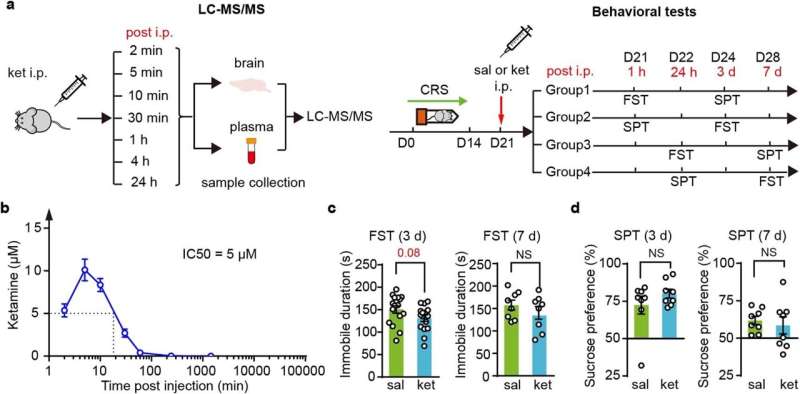November 6, 2023 report
This article has been reviewed according to Science X's editorial process and policies. Editors have highlighted the following attributes while ensuring the content's credibility:
fact-checked
peer-reviewed publication
trusted source
proofread
Study finds ketamine effects outlast half-life by getting trapped in NMDA receptors

Researchers at Zhejiang University, China, have explored mechanisms for the sustained antidepressant effects of ketamine, suggesting that a direct N-methyl-D-aspartate receptor (NMDAR) blockade might play a role.
In a paper, "Sustained antidepressant effect of ketamine through NMDAR trapping in the LHb," published in Nature, the research team presents evidence that NMDAR blockade continues even after ketamine has been eliminated from the brain, suggesting that ketamine can be trapped in NMDAR channels, which prevents it from being cleared, explaining the prolonged blockade.
Ketamine is an N-methyl-D-aspartate (NMDA) receptor antagonist known for its potent and rapid antidepressant effects. Despite its short elimination half-life, ketamine's antidepressant effects can last for at least 24 hours in the lateral habenula (LHb).
The LHb is a highly connected brain region that plays a crucial role in depression and is hyperactive in depressive states. Ketamine suppresses burst firing and blocks NMDA receptors in the LHb for an extended period.
The researchers found that by manipulating ketamine-NMDA receptor interactions in mice, the duration of ketamine's antidepressant effects could be modulated, providing potential new therapeutic opportunities.
The experiments in mice also demonstrate that ketamine's antidepressant effects last beyond its presence in the brain. Ketamine's concentrations in the plasma and brain decreased rapidly, falling below its inhibitory concentration within 30 minutes. Still, it continued to block NMDA receptors and suppress burst firing in the lateral habenula (LHb) for up to 24 hours in mice. The sustained inhibition of NMDA receptors results from trapping ketamine within the NMDA receptors.
Previous arguments against an NMDA receptor-based mechanism have pointed out the many other NMDA receptor inhibitors that fail to show comparable antidepressant effects. The current study illustrates that different NMDA receptor inhibitors have distinct inhibition mechanisms, pharmacokinetics and pharmacodynamics.
The distinct pharmaceutical features of ketamine, such as its trapping mechanism, binding affinity, and pharmacokinetics, are crucial for its antidepressant effects and optimization of these properties could be a promising future direction for developing new fast-acting, longer-lasting antidepressant treatments.
They also found that the duration of ketamine's action is influenced by local neural activity. Stimulation of the LHb when the ambient ketamine concentration is low shortens the antidepressant effects, while stimulation when the ambient ketamine level is high, extends these effects. These findings suggest that regulating and interfering with local neural activity can modulate the efficacy of ketamine in treating depression.
The sustained blockade of NMDA receptors in the LHb region appears to mediate the long-lasting antidepressant effects of ketamine, at least within a 24-hour timeframe. Beyond this, other mechanisms may come into play, possibly involving neural plasticity and secondary processes.
Clinically, the findings suggest that local application of ketamine in the LHb may produce even more long-lasting antidepressant effects and strategies to modulate local neural activity could be explored to extend the efficacy of ketamine treatment in patients with depression.
The advantage of locally applying ketamine in the lateral habenula (LHb) directly as opposed to systemic application is that much higher dosages can be used, resulting in more prolonged antidepressant effects and avoiding side effects of ketamine on peripheral organs.
The process involves targeting the LHb region and administering ketamine at a higher concentration, ensuring a more significant fraction of NMDA receptors are blocked, leading to more prolonged inhibition. The authors suggest this process could be achieved clinically through liposome delivery combined with focused ultrasound or before a deep-brain stimulation protocol in the LHb region.
The authors also highlight that local neural activity can influence the duration of ketamine's therapeutic effects. Two clinically testable strategies to extend the efficacy of ketamine treatment are mentioned, though not tested in the current study.
The first strategy involves applying ketamine during a depressive episode or activating the LHb during ketamine administration using aversive stimuli such as noise or acute stressors to open more LHb NMDA receptors for prolonged ketamine trapping.
The second strategy aims to minimize negative emotional episodes after ketamine treatment to slow down the untrapping of ketamine, potentially prolonging its effects.
More information: Shuangshuang Ma et al, Sustained antidepressant effect of ketamine through NMDAR trapping in the LHb, Nature (2023). DOI: 10.1038/s41586-023-06624-1
© 2023 Science X Network


















